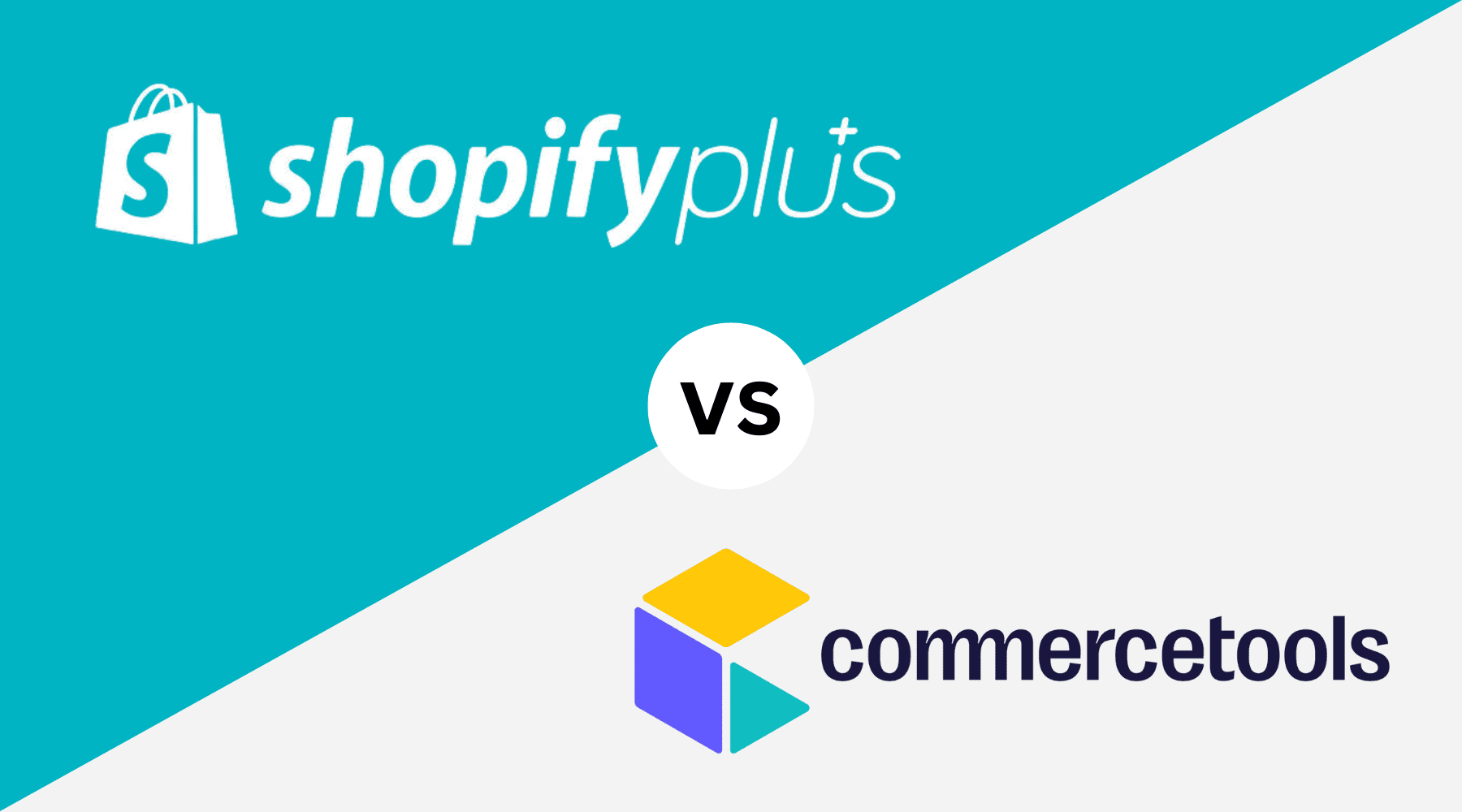If you want to scale your e-commerce business, you need to think strategically when choosing a store system. Between commercetools vs Shopify Plus, there are two platforms that are hardly comparable at first glance and yet promise the same thing: flexibility, growth, and long-term efficiency. But how different are they really?
While Shopify Plus convinces with an all-in-one solution, commercetools relies on maximum modularity through a headless setup. The key question is therefore not just, "What can the platform do?" But rather, does it fit your setup, your company, and your scaling logic?
In this article, you will find out how the platforms differ in terms of architecture, customizability, time-to-market, total cost of ownership, and scalability and which solution is better suited to your growth.
Commercetools vs Shopify Plus – Quick Overview
If you are looking for a platform for long-term growth, Shopify Plus and commercetools are the perfect choices. Both systems are aimed at ambitious companies but differ fundamentally in their technical structure.
Shopify offers you a complete hosted solution with a low barrier to entry. You can get started quickly, access a large app ecosystem, and control processes without in-depth technical expertise.
Commercetools, on the other hand, relies on an API-first model. You control all components individually via interfaces. This is ideal for complex projects that require maximum flexibility.
The following overview shows you how the two tools differ in key points:
|
Criteria |
Shopify Plus |
commercetools |
|
Business Size |
Mid-size to large B2C brands |
Enterprises & complex B2B setups |
|
Setup Time |
Fast and intuitive |
Slower, custom implementation needed |
|
Tech Resources |
Low demand, app-first approach |
High dev level required |
|
Scalability |
High, but limited to Shopify structure |
Very high, composable & flexible |
Architecture & Flexibility: Composable vs Platform-Base
The difference between the platforms starts with the architecture. Shopify relies on a closed system with a clearly defined range of functions. You work within a full-stack model in which the frontend, backend, and data structures are closely linked. This makes it easy to get started and reduces complexity, especially for brands with limited technical resources.
Commercetools takes a completely different approach. The platform is based on the MACH architecture, i.e., microservices, API-first, cloud-native, and headless. Each feature has a modular structure and can be scaled or replaced independently. You only integrate the tools you need. This increases technical freedom but requires in-depth expertise.
For developers, commercetool offers maximum control. You can adapt your infrastructure precisely to your business model. For marketers, on the other hand, this freedom can become a challenge if central functions have to be developed or integrated first. Shopify Plus scores points here with preconfigured processes that can be quickly adapted even without code.
If you need maximum customization and already have an experienced dev team, commercetools offers you the necessary technical basis. If, on the other hand, you want to go live quickly and scale your setup iteratively, Shopify provides you with a more efficient structure.

Scalability & Performance
As your business grows, your platform needs to keep pace. The difference between Commercetools vs Shopify is particularly clear when it comes to scalability and technical reliability.
Shopify is designed to start quickly and run reliably even with increasing sales. Especially in the B2C sector, Plus delivers stable performance with medium to large traffic volumes. The system offers automatic scaling, caching, and a global infrastructure. This is a clear advantage for brands that want to scale in a standardized way.
The alternative offers maximum scalability on your own terms. Thanks to the microservices architecture, you can operate and customize each function separately. This becomes a clear strength in B2B environments or international constellations with multiple markets, languages, and currencies. Traffic peaks can also be intercepted precisely without jeopardizing the system.
The technological trade-off is clear: Shopify is easier to scale but less flexible. Commercetools supports every conceivable scaling strategy but requires a dedicated technical team.
If you're following a standardized growth path and need a quick scaling time, Shopify is a solid solution. However, if you plan to expand globally and want to scale without being tied to platform logic, commercetools gives you the freedom to do just that.
Customization & Design Control
When it comes to design, it is crucial how strongly you can tie your front end to the brand. If you work with themes, you can quickly achieve a functioning result with little development effort. This is one of the biggest advantages of the Shopify world. For many B2C brands, this is completely sufficient, especially if design changes are iterative rather than in-depth.
However, as soon as you need special user flows, for example, for configurators, dynamic bundles, or personalized product logic, you reach your limits. Then you cannot avoid a headless architecture with API access. This is where the advantage of a decoupled solution comes into play: you control the entire front end independently of the back end.
Depending on your requirements, a classic theme may be sufficient, or you may need a set of specialized tools that can be neatly integrated. If you want to focus on deeper customization, it's worth working with a Shopify Plus Consulting partner.
This will allow you to use the full potential of the Storefront API and script customizations, even if you continue to work within the framework at the core.
In the end, it all depends on how much control you really need and what technical setup you can map internally.
Time to Market & Implementation Complexity
How quickly you can go live with your store depends heavily on the system you choose. With Shopify, a configured theme approach is often sufficient, supplemented by a few apps and individual settings. A functional B2C store can be set up in just a few weeks without the need for large development resources.
Commercetools takes a completely different approach. Here, every implementation begins with the definition of architecture, API logic, and interface management. Instead of relying on ready-made templates, you develop components independently or via partners. This can take several months, especially in enterprise projects with complex requirements.
In practice, this means that a fast-growing D2C label can start quickly with a preconfigured solution and scale up later. If, on the other hand, you need a platform that adapts precisely to internal processes, existing IT structures, or international requirements, you will have to invest more time and expertise.
The decision is therefore not just a technical one. It depends on how quickly you need results and how much you want to customize your commerce solution in the long term.

Cost Structures & Total Cost of Ownership (TCO)
The running costs of your e-commerce platform are made up of more than just the monthly fee. With Shopify Plus, the entry-level price is around USD 2,300 per month. The price is slightly higher for annual contracts. There are also transaction fees if external payment providers are used. For many brands, however, the total costs remain calculable, as hosting, security, and maintenance are included in the package.
The situation is different with commercetools. Here, the license starts at an average of around USD 50,000 per year, depending on your setup and traffic volume. There are additional costs for hosting, development, interfaces, and infrastructure. If you want to connect several systems, such as ERP or CRM, you will have to reckon with additional budgets, both one-off and ongoing.
The app strategy also differs significantly. While with Shopify you can solve many problems using inexpensive third-party apps, with commercetools almost everything has to be developed individually or integrated via specialized partners. This not only increases complexity but also operating costs.
If you work with an agency for Shopify Plus Development Services, you can expand your setup efficiently without going beyond the scope of the system. The TCO is therefore usually significantly lower than that of an individually developed composable stack. Ultimately, it's not just about the budget but about how much personal responsibility you want to take on in terms of technology and operation.
Ecosystem & Integration Capabilities
The question of how well external systems can be connected also determines the scalability of your platform. Shopify relies on a large app ecosystem with over 13,000 solutions. Many of them are ready to use and can be integrated without any development effort. This is ideal for brands that want to quickly add functions such as email marketing, accounting, or inventory management.
It is different with commercetools. Here, it's less about plug-and-play and more about targeted API links. The system is structured in such a way that you can control each integration individually. From the ERP system to specialized PIM solutions. This offers maximum flexibility but requires sound technical resources.
If you want to efficiently connect existing IT infrastructures, for example, to synchronize product data, customer information, or payment processes, commercetools gives you full control. On the other hand, those who prioritize speed and low complexity will benefit from the wide range of apps in the Shopify world.
Ultimately, the decision depends on whether you are looking for a standardized tool landscape or want to build a modular, developer-driven system.
When to Choose What?
Both systems have their strengths. The decisive factor is what you need and how you work. It's less about features and more about which foundation suits your company.
If you have an agile team without large development resources and want to see results quickly, there is hardly any way around a preconfigured solution. This is also the more efficient way for brands with a clear product structure and little need for integration.
If, on the other hand, you are planning a system that is deeply integrated with existing tools and can be flexibly developed in the long term, you need more technical leeway. An experienced development team is essential for this: internally or via external partners.
The following overview will help you decide:
|
Question |
Best Fit |
|
Need to launch fast with few resources? |
Platform-first setup |
|
Require tailored infrastructure? |
Choose a composable framework |
|
Low integration complexity? |
Use an app-based ecosystem |
|
Existing IT systems in place? |
Go for API-first flexibility |
|
Dev team available internally? |
Build your own architecture |

Datora Insight: Custom Shopify Development That Scales
Standard functions are often not enough if you really want your store to scale. This is exactly where Datora comes in. As a specialized Shopify Plus Development Agency, we develop individual functions that are precisely tailored to your business logic: from complex checkout flows to international rollouts.
The focus is not just on development but on real performance. With apps developed in-house and a clear understanding of conversion psychology, we provide you with the technical basis to get more out of your platform. For companies that want to scale but don't want to be dependent on third-party apps, this is the decisive lever.
It also goes further when it comes to optimisation. The CRO services for Shopify Plus help you to improve user guidance, loading times, and purchase processes in a targeted manner, with a direct impact on your conversion rate.
If you are looking for a partner who understands technology and business, Datora is your address for scalable custom development.








